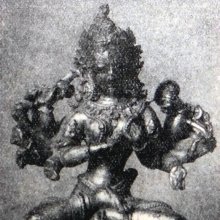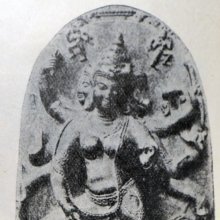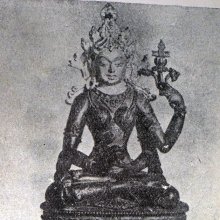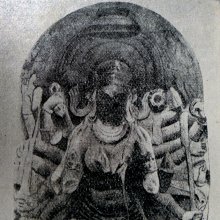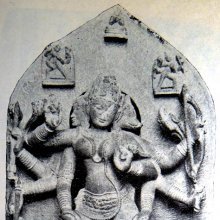Mudgara: 27 definitions
Introduction:
Mudgara means something in Buddhism, Pali, Hinduism, Sanskrit, Jainism, Prakrit, Marathi, Hindi, biology. If you want to know the exact meaning, history, etymology or English translation of this term then check out the descriptions on this page. Add your comment or reference to a book if you want to contribute to this summary article.
Images (photo gallery)
(+3 more images available)
In Hinduism
Ayurveda (science of life)
Source: Wisdom Library: Āyurveda and botanyMudgara (मुद्गर) refers to a type of fish (matsya) according to the Dhanvantari-nighaṇṭu 165.383-85. In the science of Āyurveda (ancient Indian healthcare), the meat of a fish is used and prepared in balanced diets. The Dhanvantarinighaṇṭu is a 10th-century medicinal thesaurus (nighaṇṭu) containing characteristics and synonyms of various herbal plants and minerals.

Āyurveda (आयुर्वेद, ayurveda) is a branch of Indian science dealing with medicine, herbalism, taxology, anatomy, surgery, alchemy and related topics. Traditional practice of Āyurveda in ancient India dates back to at least the first millenium BC. Literature is commonly written in Sanskrit using various poetic metres.
Dhanurveda (science of warfare)
Source: Shodhganga: Kakati Ganapatideva and his times (weapons)Mudgara refers to a hammer (or a mallet, an iron club) and represents a kind of weapon employed in warfare by the soldiers, according to Śrīnātha’s 15th century Palanāṭivīra-caritra. The Vardhmānapuram inscription states that the king should be proficient in dealing several varieties of weapons.
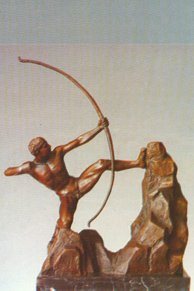
Dhanurveda (धनुर्वेद) refers to the “knowledge of warfare” and, as an upaveda, is associated with the Ṛgveda. It contains instructions on warfare, archery and ancient Indian martial arts, dating back to the 2nd-3rd millennium BCE.
Kavya (poetry)
Source: Shodhganga: The Kavyamimamsa of RajasekharaMudgara (मुद्गर) is the name a locality mentioned in Rājaśekhara’s 10th-century Kāvyamīmāṃsā.—According to Rājaśekhara this region locates in the eastern India, which is identified with Monghyr in Bihar.

Kavya (काव्य, kavya) refers to Sanskrit poetry, a popular ancient Indian tradition of literature. There have been many Sanskrit poets over the ages, hailing from ancient India and beyond. This topic includes mahakavya, or ‘epic poetry’ and natya, or ‘dramatic poetry’.
Purana and Itihasa (epic history)
Source: archive.org: Shiva Purana - English TranslationMudgara (मुद्गर) refers to “iron clubs”, according to the Śivapurāṇa 2.4.7 (“Commencement of the War”).—Accordingly, as Brahmā narrated to Nārada: “[...] Wounded and killed by great weapons, hundreds and thousands of heroic soldiers fell on the ground. The arms of some were cut off by terrible blows from swords. Others lost their thighs in the battle of those honourable, heroic people. The entire body of some was smashed by the maces; the chests and hearts of some were pounded by iron clubs (mudgara); some were felled to the ground by spears and dragged with nooses. [...]”.
Source: JatLand: List of Mahabharata people and placesMudgara (मुद्गर) is a name mentioned in the Mahābhārata (cf. I.52.9, I.57) and represents one of the many proper names used for people and places. Note: The Mahābhārata (mentioning Mudgara) is a Sanskrit epic poem consisting of 100,000 ślokas (metrical verses) and is over 2000 years old.
Source: Wisdomlib Libary: The Brahmāṇḍa-purāṇaMudgara (मुद्गर) refers to a “hammer-like weapon” and represents one of the various weapons equipped by the Daityas in their war against Lalitā, according to the Brahmāṇḍa-purāṇa 4.22. Accordingly, “[...] thereupon, crores of Daityas producing reverberating chattering noise furiously prepared themselves (to fight) against Parameśvarī (Lalitā). [...] Crores of Daityas were fully equipped with coats of mail and had the following weapons and missiles in their hands [viz.: Mudgaras (a hammer-like weapon)], and thousands of similar weapons and missiles very dreadful and capable of destroying living beings”.

The Purana (पुराण, purāṇas) refers to Sanskrit literature preserving ancient India’s vast cultural history, including historical legends, religious ceremonies, various arts and sciences. The eighteen mahapuranas total over 400,000 shlokas (metrical couplets) and date to at least several centuries BCE.
Shaktism (Shakta philosophy)
Source: Google Books: ManthanabhairavatantramMudgara (मुद्गर) (Cf. Muśala) refers to a “pestle”, according to the Manthānabhairavatantra, a vast sprawling work that belongs to a corpus of Tantric texts concerned with the worship of the goddess Kubjikā.—Accordingly, “ (Pūrṇacandrā), the goddess who resides in the door in the north is Pūrṇā Maṅgalā. She has five faces and ten arms and sits on a lion. She wears the full moon on her head. The left hands make gestures of fearlessness and boon bestowal, and hold a mirror, a noose, and goad. In the right hands she holds a dagger, bow, sword, pestle [i.e., mudgara], and a fearsome spear. She bestows boons in the north”.

Shakta (शाक्त, śākta) or Shaktism (śāktism) represents a tradition of Hinduism where the Goddess (Devi) is revered and worshipped. Shakta literature includes a range of scriptures, including various Agamas and Tantras, although its roots may be traced back to the Vedas.
Shaivism (Shaiva philosophy)
Source: SOAS University of London: Protective Rites in the Netra TantraMudgara (मुद्गर) refers to a “mallet”, according to the Netratantra of Kṣemarāja: a Śaiva text from the 9th century in which Śiva (Bhairava) teaches Pārvatī topics such as metaphysics, cosmology, and soteriology.—Accordingly, [verse 9.19cd-26, while instructing to visualize Sadāśiva in order to worship the formless Amṛteśa]—“[He] resembles the swelling moon, a heap of mountain snow. Five-faced, large-eyed, ten-armed, [and] three-armed, [he] has a serpent as a sacred thread. He is covered in a garment made of tiger skin. [He] sits in the bound lotus pose atop a white lotus, [holding] a trident, blue lotus, arrow, rudrākṣa, [and] a mallet (sa-mudgara). The highest is done in the right and heard in the left. [...]”.

Shaiva (शैव, śaiva) or Shaivism (śaivism) represents a tradition of Hinduism worshiping Shiva as the supreme being. Closely related to Shaktism, Shaiva literature includes a range of scriptures, including Tantras, while the root of this tradition may be traced back to the ancient Vedas.
General definition (in Hinduism)
Source: Wisdom Library: HinduismMudgara (मुद्गर) is a Sanskrit word for a weapon translating to “club”. Sculptures or other depictions of Hindu dieties are often seen holden this weapon in their hand.
In Buddhism
Tibetan Buddhism (Vajrayana or tantric Buddhism)
Source: academia.edu: The Structure and Meanings of the Heruka MaṇḍalaMudgara (मुद्गर) refers to a “hammer” and represents one of the items held in the right hand of Heruka: one of the main deities of the Herukamaṇḍala described in the 10th century Ḍākārṇava chapter 15. Heruka is positioned in the Lotus (padma) at the center; He is the origin of all heroes; He has 17 faces (with three eyes on each) and 76 arms [holding, for example, mudgara]; He is half black and half green in color; He is dancing on a flaming sun placed on Bhairava and Kālarātrī.
Source: OSU Press: Cakrasamvara SamadhiMudgara (मुद्गर) refers to a “hammer”, according to the Cakrasaṃvara Samādhi [i.e., Cakrasamvara Meditation] ritual often performed in combination with the Cakrasaṃvara Samādhi, which refers to the primary pūjā and sādhanā practice of Newah Mahāyāna-Vajrayāna Buddhists in Nepal.—Accordingly, “By the form of a skull cup, and by the letter Māṃ, Vāruṇī, Eighteen arms, one face, red color, and three eyes, A sword, arrow and hook, on the right, a skull cup, ax and banner, Thus a mace, thus a bell, and in the ninth, granting wishes, A two-headed drum, a bow and noose, a staff and a water pot, A trident, hammer (mudgara) and lute, and thus a number, in the upper hand, A young adolescent beauty, a great beauty, a beautiful goddess”.

Tibetan Buddhism includes schools such as Nyingma, Kadampa, Kagyu and Gelug. Their primary canon of literature is divided in two broad categories: The Kangyur, which consists of Buddha’s words, and the Tengyur, which includes commentaries from various sources. Esotericism and tantra techniques (vajrayāna) are collected indepently.
In Jainism
General definition (in Jainism)
Source: archive.org: TrisastisalakapurusacaritraMudgara (मुद्गर) is the name of an ancient kingdom, according to chapter 4.2 [vāsupūjya-caritra] of Hemacandra’s 11th century Triṣaṣṭiśalākāpuruṣacaritra: an ancient Sanskrit epic poem narrating the history and legends of sixty-three illustrious persons in Jainism.
Accordingly, as Vasupūjya and Jayā spoke to Vāsupūjya:—“All the existing kings, among men and the Vidyādharas, who are of good family, capable, heroic, wealthy, famous, possessing the fourfold army, known for guarding their subjects, free from blemish, faithful to engagements, always devoted to dharma, in Madhyadeśa, Vatsadeśa, [... the Mudgaras, ...] these now, son, beg us constantly through messengers, who are sent bearing valuable gifts, to give their daughters to you. [...]”.

Jainism is an Indian religion of Dharma whose doctrine revolves around harmlessness (ahimsa) towards every living being. The two major branches (Digambara and Svetambara) of Jainism stimulate self-control (or, shramana, ‘self-reliance’) and spiritual development through a path of peace for the soul to progess to the ultimate goal.
Biology (plants and animals)
Source: Wisdom Library: Local Names of Plants and DrugsMudgara [मुद्गर] in the Sanskrit language is the name of a plant identified with Jasminum malabaricum Wight from the Oleaceae (Jasmine) family. For the possible medicinal usage of mudgara, you can check this page for potential sources and references, although be aware that any some or none of the side-effects may not be mentioned here, wether they be harmful or beneficial to health.
Source: Google Books: CRC World Dictionary (Regional names)1) Mudgara in India is the name of a plant defined with Averrhoa carambola in various botanical sources. This page contains potential references in Ayurveda, modern medicine, and other folk traditions or local practices.
2) Mudgara is also identified with Jasminum malabaricum.
3) Mudgara is also identified with Jasminum sambac It has the synonym Nyctanthes undulata L. (etc.).
Example references for further research on medicinal uses or toxicity (see latin names for full list):
· A General History of the Dichlamydeous Plants (1837)
· Biodiversidad del estado de Tabasco (2005)
· Prodr. (DC.) (1844)
· Revisio Generum Plantarum (1891)
· Investigatio et Studium Naturae (1992)
· Flora of the British India (1882)
If you are looking for specific details regarding Mudgara, for example side effects, diet and recipes, pregnancy safety, health benefits, chemical composition, extract dosage, have a look at these references.

This sections includes definitions from the five kingdoms of living things: Animals, Plants, Fungi, Protists and Monera. It will include both the official binomial nomenclature (scientific names usually in Latin) as well as regional spellings and variants.
Languages of India and abroad
Marathi-English dictionary
Source: DDSA: The Molesworth Marathi and English Dictionarymudgara (मुद्गर).—m S See the derivative mudagala.
Marathi is an Indo-European language having over 70 million native speakers people in (predominantly) Maharashtra India. Marathi, like many other Indo-Aryan languages, evolved from early forms of Prakrit, which itself is a subset of Sanskrit, one of the most ancient languages of the world.
Sanskrit dictionary
Source: DDSA: The practical Sanskrit-English dictionaryMudgara (मुद्गर).—[mudaṃ girati gṝ-ac]
1) A hammer, mallet, as in मोहमुद्गरः (mohamudgaraḥ) (a small poem by Śaṅkarāchārya); समधूच्छिष्ट- मुद्गराः (samadhūcchiṣṭa- mudgarāḥ) Mahābhārata (Bombay) 5.155.; शिलानिष्पिष्टमुद्गरः (śilāniṣpiṣṭamudgaraḥ) R.12.73.
2) A club, mace.
3) A staff for breaking clods of earth.
4) A kind of dumb-bell.
5) A bud.
6) A kind of jasmine (said to be n. also in this sense).
7) A particular posture in sitting.
Derivable forms: mudgaraḥ (मुद्गरः).
Source: Cologne Digital Sanskrit Dictionaries: Edgerton Buddhist Hybrid Sanskrit DictionaryMudgara (मुद्गर).—nt. (in Sanskrit m.), hammer: in Saddharmapuṇḍarīka 271.9 (verse) read with Kashgar recension daṇḍāni mudgarāṇī ca (supported [Page435-a+ 71] confusedly by 2 Nepalese mss. and the fragment publ. by LaVallée-Poussin JRAS 1911.1076).
Source: Cologne Digital Sanskrit Dictionaries: Shabda-Sagara Sanskrit-English DictionaryMudgara (मुद्गर).—m.
(-raḥ) 1. A mallet, a mace, a weapon formed like a carpenter’s hammer. 2. A staff, armed with iron, and larger at the lower extremity, used for breaking clods of earth, &c. 3. A carpenter’s hammer. 4. A sort of flower, said to be a kind of jasmine, perhaps jasminum zambac, (the wild variety.) E. mud pleasure, ga to swal- low or destroy, aff. ac; also with ra changed to la, mudgala “karmāra vṛkṣe ca; kāmrāṅgā iti bhāṣā .”
Source: Cologne Digital Sanskrit Dictionaries: Benfey Sanskrit-English DictionaryMudgara (मुद्गर).—m. 1. A carpenter’s hammer. 2. A mace, Rām, 3, 54, 10; [Sundopasundopākhyāna] 2, 3. 3. A staff armed with iron, used for breaking clods of earth. 4. A sort of flower.
Source: Cologne Digital Sanskrit Dictionaries: Cappeller Sanskrit-English DictionaryMudgara (मुद्गर).—[masculine] hammer, mallet.
Source: Cologne Digital Sanskrit Dictionaries: Monier-Williams Sanskrit-English Dictionary1) Mudgara (मुद्गर):—[from mud] m. ([probably] [from] mudga) a hammer, mallet, any hammer-like weapon or implement, [Mahābhārata; Kāvya literature] etc.
2) [v.s. ...] a bud, [cf. Lexicographers, esp. such as amarasiṃha, halāyudha, hemacandra, etc.]
3) [v.s. ...] a kind of jasmine (n. its blossom), [cf. Lexicographers, esp. such as amarasiṃha, halāyudha, hemacandra, etc.]
4) [v.s. ...] a species of fish, [cf. Lexicographers, esp. such as amarasiṃha, halāyudha, hemacandra, etc.]
5) [v.s. ...] Name of a Nāga, [Mahābhārata]
6) [v.s. ...] n. a [particular] posture in sitting, [Catalogue(s)]
Source: Cologne Digital Sanskrit Dictionaries: Yates Sanskrit-English DictionaryMudgara (मुद्गर):—(raḥ) 1. m. A mallet, a club, carpenter’s hammer; jasmin.
Source: DDSA: Paia-sadda-mahannavo; a comprehensive Prakrit Hindi dictionary (S)Mudgara (मुद्गर) in the Sanskrit language is related to the Prakrit words: Muggara, Moggara.
[Sanskrit to German]
Sanskrit, also spelled संस्कृतम् (saṃskṛtam), is an ancient language of India commonly seen as the grandmother of the Indo-European language family (even English!). Closely allied with Prakrit and Pali, Sanskrit is more exhaustive in both grammar and terms and has the most extensive collection of literature in the world, greatly surpassing its sister-languages Greek and Latin.
Hindi dictionary
Source: DDSA: A practical Hindi-English dictionaryMudgara (मुद्गर):—(nm) see [mugadara].
...
Kannada-English dictionary
Source: Alar: Kannada-English corpusMudgara (ಮುದ್ಗರ):—
1) [noun] a hammer.
2) [noun] any hammer-like weapon.
3) [noun] a flower bud; an unblown flower.
4) [noun] a kind of fish.
5) [noun] a variety of jasmine.
6) [noun] its flower.
Kannada is a Dravidian language (as opposed to the Indo-European language family) mainly spoken in the southwestern region of India.
See also (Relevant definitions)
Starts with: Mudgaragomin, Mudgaraka, Mudgarakara, Mudgarapani, Mudgaraparnaka, Mudgaraphala, Mudgarapindaka, Mudgarasa.
Ends with: Antahsthamudgara, Krimimudgara, Kutamudgara, Mohamudgara, Samudgara, Vadighatamudgara, Vajramudgara, Vyomamudgara.
Full-text (+45): Vyomamudgara, Phalamudgarika, Kutamudgara, Muggara, Atigandha, Vrittapushpa, Mudgarapindaka, Mudgaragomin, Mudgaraphala, Mudgaraparnaka, Nagangana, Muharaparnaka, Saptapattra, Vadighatamudgara, Moggara, Antahsthamudgara, Ayamurkaravan, Mudgarakara, Mohamudgara, Siddhapati.
Relevant text
Search found 27 books and stories containing Mudgara; (plurals include: Mudgaras). You can also click to the full overview containing English textual excerpts. Below are direct links for the most relevant articles:
Garga Samhita (English) (by Danavir Goswami)
Verse 5.8.38 < [Chapter 8 - The Killing of Kaṃsa]
Nitiprakasika (Critical Analysis) (by S. Anusha)
Kavyamimamsa of Rajasekhara (Study) (by Debabrata Barai)
Part 8.4 - The region of Pūrvadeśa (eastern part) < [Chapter 5 - Analyasis and Interpretations of the Kāvyamīmāṃsā]
Appendix 2 - Identification of Geographical names mentioned in the Kāvyamīmāṃsā
Yoga-sutras (Vedanta Commentaries)
Sūtras 37-39 < [Part III - Powers]
Trishashti Shalaka Purusha Caritra (by Helen M. Johnson)
Thirty-six weapons < [Notes]
Part 7: Refusal to marry < [Chapter II - Vāsupūjyacaritra]
Appendix 3.2: new and rare words < [Appendices]
The Devi Bhagavata Purana (by Swami Vijñanananda)
Related products

